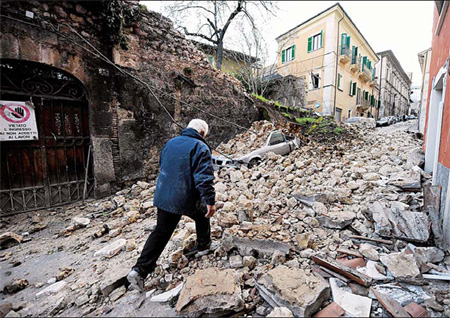Italy's L'Aquila a ghost town 1 year after quake
A year after a violent earthquake devastated the central Italian city of L'Aquila, survivors will mark the somber anniversary on Tuesday with a candlelight march through streets still strewn with rubble.
 |
|
A man looks for relatives in the ruins of a collapsed house on April 6, 2009 in L'Aquila, the epicenter of an earthquake measuring 5.8-magnitude on the Richter scale.[China Daily via Agencies] |
Neither Prime Minister Silvio Berlusconi nor President Giorgio Napolitano plan to visit the zone, where 308 inhabitants died and thousands were forced to flee their homes.
The medieval walled city, the Abruzzo capital that is home to a prestigious university and rich in art and architecture, remains off limits to residents.
Quake survivors complain that the authorities are favouring the building of new homes at great cost far from the city center instead of placing priority on rebuilding the city center.
"All the resources have been spent on building new neighborhoods out of nothing," said Alessandro Tettamanti, spokesman of a victims' advocacy group.
"They're dormitory cities with nothing," he said, noting that the new housing lacks essentials such as transport links, public services and shops.
"This money could have been used differently, especially since these homes cost three times more than planned. With that sort of money they could have housed 45,000 people, not only 14,000," said Eugenio Carlomagno, a co-founder of the Committee for a Living City Center.
Of some 120,000 people affected by the earthquake in and around L'Aquila, more than 52,000 have yet to return home or are living in hotels along the Adriatic seacoast or in barracks at public expense.
"It will take many years to restore some of the monuments, while for the homes, it's a matter of between eight months and two or three years," Carlomagno said.
"We have to get the water, electricity and gas working again... but nothing has been done, not even a feasibility study," he said.
In a series of Sunday protests, displaced residents had pushed wheelbarrows through the off-limits streets of L'Aquila, loading them with rubble, to protest against the slow pace of reconstruction.
The protests, dubbed the "wheelbarrow revolt," forced the administration to react.
"It's not normal that we have to resort to these kinds of actions to make things happen," Carlomagno said.
Italy's civil protection agency says up to three million cubic meters (100 million cubic feet) of rubble still need to be removed.
Tettamanti blamed the city's mayor, Massimo Cialente, for his "being a lightweight compared to Guido Bertolaso", the head of of the civil protection agency, who was given sweeping powers in the catastrophe's aftermath.
"The government has done a lot, but we still haven't found a definitive solution to the housing problem," Cialente said.
"There's no alternative to rebuilding the historical centre, of course, but I'm not really sure we will have the money to do it," the mayor said.
The issue is a thorny one, and well-known satirist Sabina Guzzanti has decided to address it in a documentary movie based on interviews with citizens, titled Draquila - Italy Shaking.
Guzzanti's film is expected to deal with a broad corruption scandal involving Bertolaso in the awarding of public works contracts in L'Aquila after the earthquake.
 0
0 







Go to Forum >>0 Comments